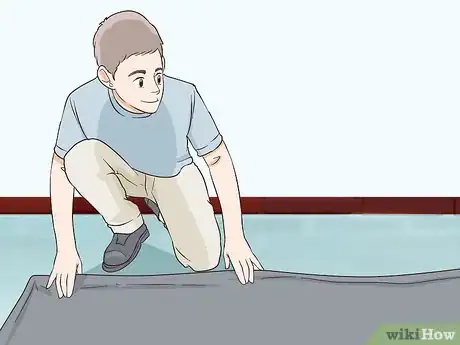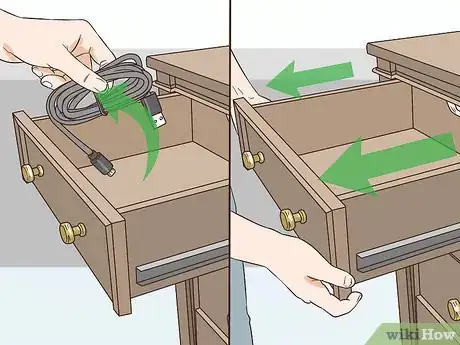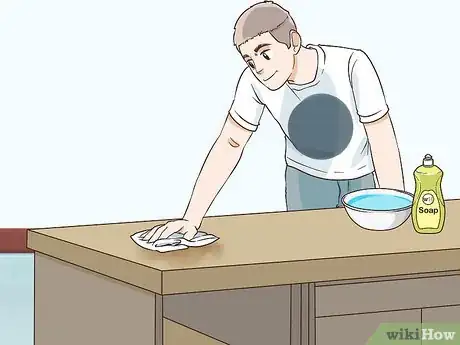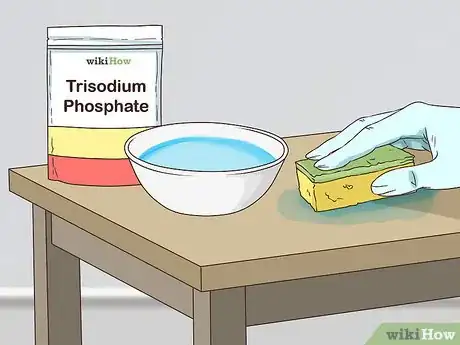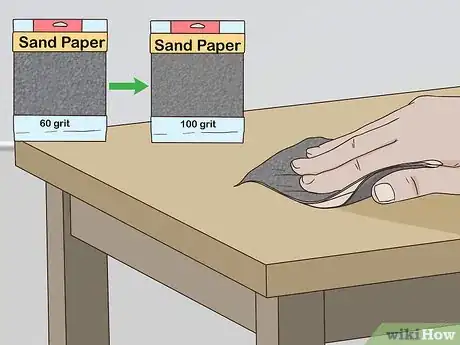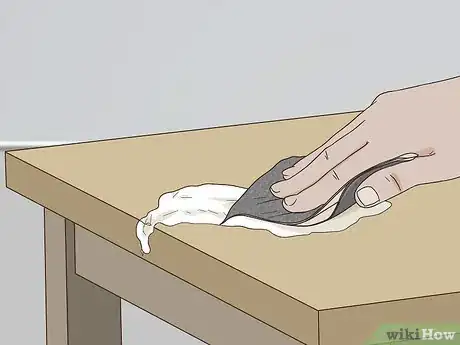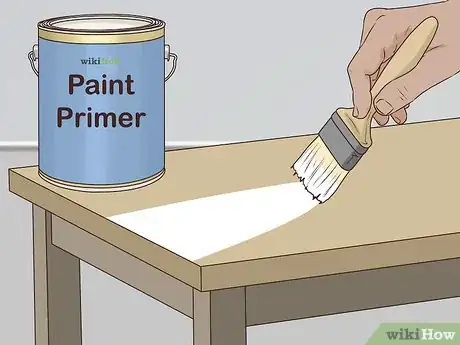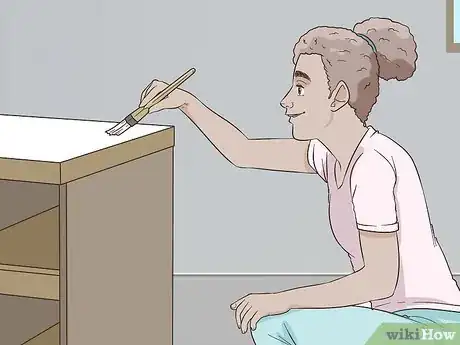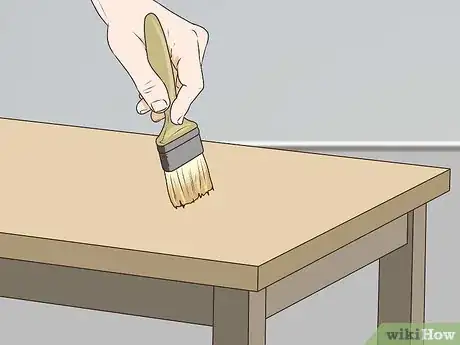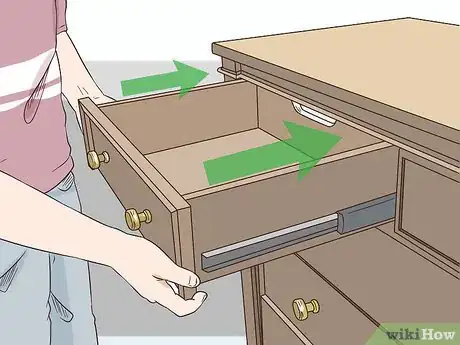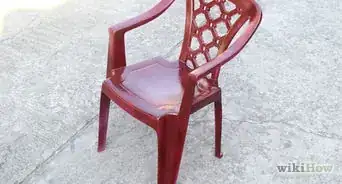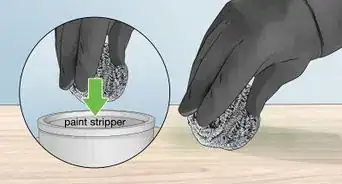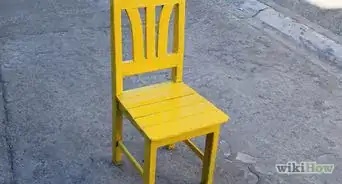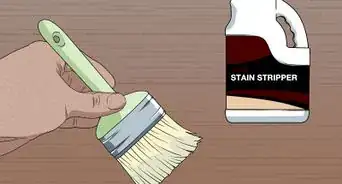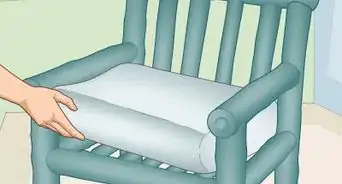This article was co-authored by Sam Adams. Sam Adams is the owner of Cherry Design + Build, a residential design and construction firm, which has been operating in the Greater Seattle Area for over 13 years. A former architect, Sam is now a full-service contractor, specializing in residential remodels and additions.
There are 7 references cited in this article, which can be found at the bottom of the page.
This article has been viewed 39,571 times.
Painting over stained wood can be a great way to give your furniture a new and refreshed look. Whether you’re hoping to make your home look more modern, or give it a rustic feel, paint can be an easy and effective tool for changing up your style. Even wood that has been stained a dark color can be painted over using the proper tools and techniques. All you’ll need to give your wood a new coat of paint is sand paper or a deglosser liquid, spackle, primer, and your favorite wood paint.
Steps
Preparing the Wood
-
1Lay down a tarp to protect the floor and any nearby furniture. Use a long tarp that you don’t mind getting dirty to cover the ground beneath the wood. If you're painting outside, lay the tarp on the ground beneath your work station. If you’re painting indoors, put the tarp on the floor and over nearby furniture. Make sure you’re working in an open and airy space to avoid extended exposure to paint fumes.
- Use a rock or heavy object to weigh down the corners of the tarp.
-
2Remove the hardware from the wood. Take off any door knobs or handles from the wood you want to paint. Pull out any cabinet drawers and lay them to the side to paint separately.
- If you accidentally get paint or primer on the hardware, use a wet cloth to wipe off latex-based paints, or paint thinner to wipe off oil-based paints.
Advertisement -
3Clean the wood with soap and water. To avoid creating a bumpy surface, it’s important to use a wet rag and soap to clean off any dust or debris from your wood before painting. This will make it easier to sand the wood, and will ensure that no excess dust gets mixed in with the paint.
-
4Clean off grease with trisodium phosphate. If the surface of your wood is greasy, dip a sponge in a trisodium phosphate (TSP) solution and wipe onto the surface of the wood. Let the TSP soak in for a minute or two then scrub the surface with the sponge before rinsing off.[1]
- Always use gloves when working with TSP. If you accidentally get TSP on yourself just rinse it off with soap and water.
- Be sure to rinse off all of the TSP from the surface of the wood to avoid interactions with the paint.
Removing the Gloss
-
1Sand away the gloss. Use 60 to 100-grit sandpaper to remove the upper layer of gloss from your wood, leaving the surface looking dull.[2] Alternatively, you can paint on a deglosser liquid with a brush and let it soak in for at least 15 minutes to remove the gloss.[3]
- Consider wearing a dust mask and eye protection while sanding to ensure your safety.
- Vacuum up any dust created from sanding, and wipe down the surface with a damp cloth.
-
2Fill in any cracks with spackling paste. To ensure the surface of your wood is level, use a putty knife to fill any holes or cracks with a spackling paste. Let the paste dry for a 1-2 hours before continuing. Apply numerous layers as needed.[4]
-
3Sand over bumps. Use 100 to 120-grit grade sandpaper to remove any bumps or scratches either in the wood or from the spackling paste.
Applying the Paint
-
1Choose between oil and latex-based paint. Choose oil-based paint for projects that require a tough exterior, like for covering doors. Choose a latex-based paint for most other projects, especially in locations that are not prone to rust.[5]
- Oil-based paints require extra ventilation, more drying time, and contain more volatile organic compounds.
- Latex-based paints tend to dry faster, and require less extensive cleanup.
-
2Paint on a paint primer and leave it to dry. If you plan to use an oil-based paint to cover your wood, use an oil-based primer. If you plan to use a latex-based paint, then use a water-based latex primer. Let the primer dry as directed. Oil-based primers can take up to 24 hours, while latex-based primers typically dry in up to 4 hours.
- Always work in a well ventilated room when applying primer. Open doors and windows to promote airflow, or work in an outdoor space.
- Some paints are mixed in with primer. Check if this is the case for the paint you’re using. If so, you can skip applying a primer before the paint.
- At some paint shops you can buy tinted primer to enrich the color that you paint overtop.
-
3Apply the first coat of paint and leave it to dry. If you're using an oil-based paint, use a natural bristle brush to apply an even layer of paint to the wood, and leave it to dry for at least 8 hours. Alternatively, if you're using a latex-based paint, use any paint brush or roller to apply an even layer of paint, and leave it to dry for at least 4 hours.[6]
-
4Apply any additional coats of paint needed and let dry. Paint over the wood with your paint after the first layer has completely dried. Continue painting on layers until you’ve reached your desired color, letting the paint dry between each fresh coat.[7]
-
5Reassemble the hardware. Once the wood has completely dried, reattach any door knobs, handles, or cabinets that you had removed before painting.
-
6Clean up the workspace. Remove the tarp from the floor and sweep up any excess dust from sanding. Be sure to reattach the lids to all paint and primer containers by tapping the lids with a mallet, and store in a cool, dark environment for later use.[8]
- Wipe off any excess paint around the paint cans using a clean rag before storing.
- Use paint thinner to clean off brushes used for oil-based paints.
Expert Q&A
-
QuestionWhat type of paint do you use over stained wood?
 Sam AdamsSam Adams is the owner of Cherry Design + Build, a residential design and construction firm, which has been operating in the Greater Seattle Area for over 13 years. A former architect, Sam is now a full-service contractor, specializing in residential remodels and additions.
Sam AdamsSam Adams is the owner of Cherry Design + Build, a residential design and construction firm, which has been operating in the Greater Seattle Area for over 13 years. A former architect, Sam is now a full-service contractor, specializing in residential remodels and additions.
Professional Contractor Consider how long ago the stain was applied. If it's an old stain, you don't have to do anything special in regards to paint. If it's a fresh stain, my advice is to use oil-based paint because most subtle stains are oil based. If you have fresh oil stains and you go over it with latex paint, the paint could fail.
Consider how long ago the stain was applied. If it's an old stain, you don't have to do anything special in regards to paint. If it's a fresh stain, my advice is to use oil-based paint because most subtle stains are oil based. If you have fresh oil stains and you go over it with latex paint, the paint could fail.
Warnings
- Both primer and wood paint can give off harmful fumes. Always wear a paint mask and be sure to work outdoors or in a well ventilated room.⧼thumbs_response⧽
Things You'll Need
- Tarp
- Trisodium Phosphate solution (optional for grease removal)
- Gloves
- Sponge
- Deglosser liquid (optional)
- Spackle (optional)
- 60 to 100-grit sandpaper
- Paint brush or roller
- Primer (oil-based or latex-based)
- Wood paint (oil-based or latex-based)
References
- ↑ https://projects.truevalue.com/paint/staining/wood_surfaces/refinish_your_wood_furniture.aspx
- ↑ https://youtu.be/Tg_4Kxij3ts?t=185
- ↑ https://julieblanner.com/paint-without-sanding/
- ↑ https://projects.truevalue.com/paint/interior/prep_cleanup_and_safety/proper_spackling_techniques.aspx
- ↑ https://thecraftsmanblog.com/oil-vs-latex-which-paint-is-best/
- ↑ https://thecraftsmanblog.com/how-to-paint-with-oil-based-paint/
- ↑ https://thecraftsmanblog.com/how-to-paint-with-oil-based-paint/
- ↑ https://www.youtube.com/watch?v=M2P8A5jpxhg&feature=youtu.be&t=27
